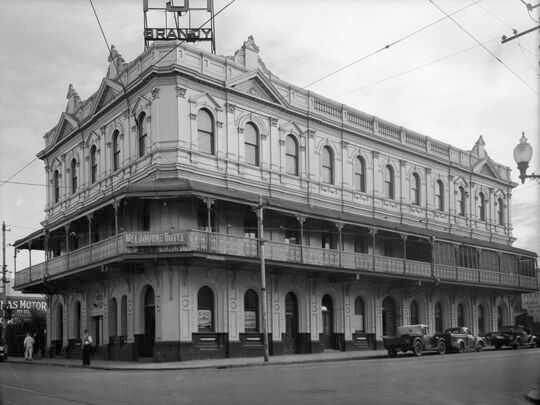Our spring 2021 newsletter details the adventures of John and Albert DeBaun, who left Upper Saddle River in the 1870s and journeyed farther than anyone from USR had ever been - to Adelaide, Australia. The DeBauns were loyalists and supported Lincoln and emancipation and the family was involved in local politics. They also likely felt a connection to the broader British Empire, including Australia. They may not have known anyone, but landed and made their way. Below are additional photographs of the Outback towns that they made their mark on and the various hotels they constructed, several of which still survive, as well as photos of Albert DeBaun’s descendants. Their journey was very unique and their early impact on the growth of Australia seems to be recognized to this day.
Albert Hopper DeBaun, born in Upper Saddle River in 1857. Photo courtesy of Albert’s great granddaughter, Clare Macken, of Sydney, Australia.
John DeBaun, born in the James DeBaun house in Upper Saddle River, NJ in 1852.
This overhead image from about 1950 shows the James DeBaun farm on West Saddle River Road in Upper Saddle River, where John and Albert were born. The house still stands, but the barns are no longer extant.
John and Albert initially settled in Wilcannia, NSW, but made their way to Silverton and Broken Hill, where they invested in ancillary businesses that helped the mining industry. Albert continued west to Boulder, Western Australia.
View of Silverton, New South Wales. John DeBaun’s hotel on Bourke Street is the 2-floor structure with double porches on the right. It is no longer standing.
A drawing, likely done from the image above, in 1887, showing John DeBaun’s hotel on the right.
Circa 1885 view of Burke Street in Silverton looking west with John DeBaun’s hotel on the left.
As included in the caption above, this image shows John DeBaun’s hotel in 1888 when Lord Carrington, Governor of New South Wales, visited. It brought quite a crowd.
This image was taken in 1967 of the remaining ruins of John’s hotel. The foundation is still there today. The town is essentially a ghost town now, with the population very much shrunken and industry focused on tourism.
An article from the Express and Telegraph (Adelaide, SA) mentioning John’s return trip February 4, 1886 to Upper Saddle River, after making a small fortune in Silverton.
This 1931 image from the Australia National University Archives shows John DeBaun’s hotel in Broken Hill, NSW.
This early image shows what Broken Hill looked like at the height of the mining boom.
From Broken Hill, John moved west to Coolgaridie in Western Australia. This wonderful print was done in the late 1800s and shows an overall view of Coolgardie, though John DeBaun’s bakery and hotel and not visible in the image.
John De Baun’s Great Western Hotel, also known as De Baun’s, in Coolgardie in 1894. It was built as a simple barrack for miners, but began as just a bakery with John selling bread made in a simple oven.
Stagecoaches outside the Great Western Hotel in Coolgardie, Western Australia, likely in the 1890s.
This image from 1894 shows the series of buildings that made up the Great Western Hotel in Coolgardie. The caption on the photo reads, “Coach leaving J. De Baun G-Western Hotel For Southern ….? Coolgardie ?/12/1894”
John’s first wife, Rachel, died in 1895 while they were living in Coolgardie, Western Australia. This is an image of her broken gravestone.
John left Coolgardie for Perth and either leased or sold the Great Western. It burned down in 1897. This image shows the aftermath of the fire. The same chimney is visible that appears in the image above.
John purchased the Freemasons Hotel in Perth, seen here, which housed one of the country’s first pubs. He demolished it to construct the Palace Hotel (below) on St. Georges Terrace.
The Palace Hotel, Perth, c. 1905, which occupied a prominent corner location. John hired architects Ernest Saunders Porter and Edmond Neville Thomas to design the structure.
View of Perth in 1890 with the Palace Hotel on the left.
Palace Hotel Dining Room c. 1910
The former dining room of the Palace Hotel has been restored and currently houses Meat & Wine Perth, as seen above.
Palace Hotel, Perth, Smoking Lounge c. 1910
This is a more recent image of what the lobby of the Palace Hotel looked like. The building has been renovated with a tower extending above it and most of the interior spaces gutted, apart from the former restaurant.
c. 1930s view of John’s Melbourne Hotel in Perth before it was enlarged (and then contracted). It serves as a high-end hotel today by the same name.
Current view of the Melbourne Hotel (2020) with its large, contemporary addition.
Near the end of his life, John De Baun, leased his Palace Hotel to a congressman and bought a fleet of 2-masted schooner ships that were constructed in Fremantle, outside Perth between 1903 and 1907. He had them sailed to the north coast of Australia, over 1,000 miles, where he endeavored to try his hand in the pearling industry. He settled in the town of Broome, seen above.
This image shows a number of 2-masted pearling “luggers” like the ones John De Baun owned. It was taken in Thursday Island around 1910. Six of John’s ships were lost in a typhoon that killed dozens of people.
The obituary of Albert De Baun, from 1918.
Albert John De Baun, Esq, in 1912, when he was awarded a scholarship at Melbourne University. He was born in Menindee (Broken Hill), New South Wales, in 1894 and died in Sydney in 1961.
Albert John De Baun in his 20s
Albert Hopper De Baun’s son, Albert John De Baun, Esq. and his wife, Ethel B. Williams, later in life.
John’s second marriage took place in Perth, to Ada B. Williams.



































